Recent Water Damage Posts
The Aftermath of Water Damage: Effective Strategies for Handling Mold and Mildew
2/9/2024 (Permalink)
Water damage is a common occurrence in homes and can lead to the growth of mold and mildew if not properly addressed. In this blog post, we will explore the aftermath of water damage and discuss effective strategies for handling and preventing mold and mildew growth in order to restore a safe and healthy living environment.
Assessing the Extent of Damage
After water damage occurs, it is vital to assess the extent of the damage to determine areas prone to mold and mildew growth. Conduct a thorough inspection of affected surfaces, including walls, ceilings, floors, and furniture. This assessment will provide insights into the severity of the problem and guide subsequent steps for remediation.
Prompt Water Extraction and Drying
The key to preventing mold and mildew growth is to eliminate excess moisture promptly. Utilize water extraction tools and fans to remove standing water and promote air circulation. Additionally, employ dehumidifiers to reduce humidity levels and speed up the drying process. Fast action will inhibit the growth of mold and mildew, minimizing further damage.
Professional Mold and Mildew Remediation
In severe cases, it is essential to enlist the help of professional mold and mildew remediation experts. These specialists have the knowledge and equipment to safely and effectively remove mold and prevent its return. They will conduct a thorough assessment, perform necessary repairs, utilize proper containment measures, and apply specialized cleaning agents to eliminate mold and mildew colonies.
Preventive Measures for Future Protection
Preventing mold and mildew growth after water damage involves implementing preventive measures. Ensure proper ventilation in high-humidity areas, such as bathrooms and kitchens. Regularly inspect and address any signs of water leakage or condensation. Improve insulation to reduce the likelihood of moisture build-up. Additionally, consider using mold-resistant materials when renovating or repairing affected areas.
Monitoring and Maintenance
Even after the initial cleanup, it is crucial to monitor the affected areas for any signs of mold or mildew regrowth. Regularly inspect and promptly address any water issues that arise. Perform routine cleaning and maintenance to prevent the accumulation of moisture. Stay vigilant and proactive to maintain a mold-free environment.
Handling mold and mildew is a critical aspect of water damage restoration. By promptly removing water, enlisting professional help when necessary, implementing preventive measures, and conducting regular maintenance, homeowners can effectively minimize the risk of mold and mildew growth, ensuring a safe and healthy living space after experiencing water damage. Give SERVPRO of Boston Downtown / Back Bay / South Boston / Dorchester a call today for your water restoration emergency.
Managing Water Damage in Condos and Apartments: Responsibilities and Collaborative Solutions
10/17/2023 (Permalink)
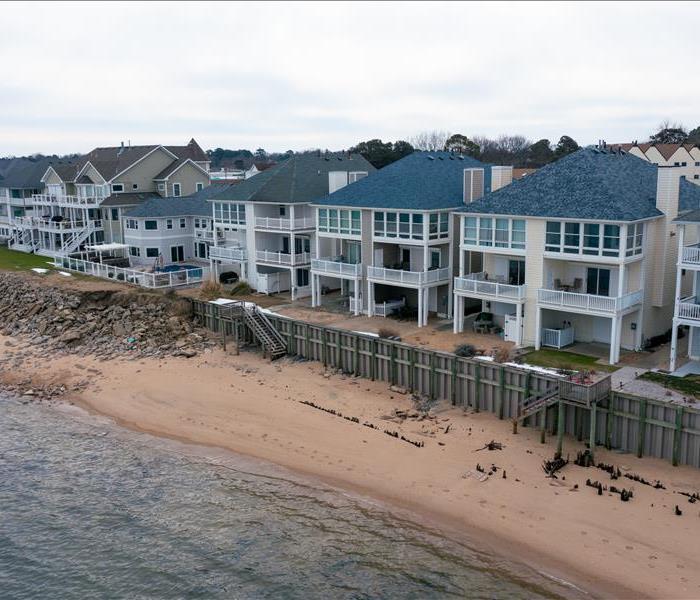 When your condo suffers from a water loss, SERVPRO can help!
When your condo suffers from a water loss, SERVPRO can help!
Living in a condo or an apartment has its advantages, from convenient amenities to a sense of community. However, when it comes to water damage, the responsibility for addressing and repairing the damage can become complicated. In this blog post, we will explore the different responsibilities of landlords, property management, and tenants in handling water damage incidents in condos and apartments. Additionally, we will discuss effective solutions to prevent and address water damage to ensure a safe living environment.
Landlord's Responsibilities
Landlords are responsible for maintaining the building's structure, including the roof, plumbing system, and exterior. Any negligence in maintaining these elements can result in water damage.
Promptly addressing water leaks and repairs: Landlords should respond quickly to reports of water leaks or other plumbing issues within the property. Timely repairs can prevent minor issues from escalating into major water damage incidents.
Landlords should have sufficient insurance coverage to protect the building's structure and common areas from water damage. This coverage should extend to repairs and replacements necessary to restore the affected areas.
Property Management's Role
Property management teams should conduct regular inspections of units, common areas, and building systems to identify potential sources of water damage. Maintaining a proactive approach helps prevent water damage incidents in the first place.
Property managers should educate tenants on necessary precautions to avoid water damage, such as proper use of plumbing fixtures, reporting leaks promptly, and avoiding actions that can cause water damage (e.g., leaving taps running, overloading washing machines). In the event of water damage, property management should promptly coordinate repairs and restoration efforts with trusted professionals. Their role includes ensuring that the affected unit or area is restored to its pre-damaged condition efficiently and effectively.
Tenant Responsibilities
Tenants should report any water leaks or suspicious moisture buildup to the property management or landlord immediately. Timely reporting helps prevent further damage and allows for swift action to be taken. Tenants should use plumbing fixtures responsibly, avoiding improper disposal of items that can cause clogs or damage the plumbing system. Proper maintenance and care go a long way in preventing water damage incidents.
Tenants should take proactive measures to prevent water damage, such as using doormats to prevent water tracking, regularly inspecting and cleaning drainages, and using appropriate protective measures for valuable belongings.
Effective Solutions for Water Damage Prevention and Restoration
Regular inspections of plumbing systems, roofs, and common areas can help identify potential issues and address them before they escalate into significant water damage incidents. Ensuring proper functioning and maintenance of drainage systems can prevent water from accumulating and causing damage in common areas or individual units.
Water detection systems can alert tenants and property management to potential leaks or water accumulation, allowing for swift action and minimizing damage. Raising awareness among tenants about preventive measures and responsible usage of plumbing fixtures can significantly reduce the risk of water damage incidents.
In conclusion, addressing water damage in condos and apartments requires a collaborative effort between landlords, property management, and tenants. Each party has specific responsibilities in preventing, detecting, and addressing water damage incidents promptly. By fulfilling these responsibilities and implementing effective preventive measures, the risk of water damage can be minimized, ensuring a safe and habitable living environment for all residents.
Is It Normal to Have Water in My Crawlspace?
7/25/2023 (Permalink)
Discovering water in your crawlspace can be concerning, and it's natural to wonder if it's a common occurrence or a cause for alarm. In this blog, we will explore the question, "Is it normal to have water in my crawlspace?" We will discuss the potential causes of water intrusion, the risks associated with a wet crawlspace, and the steps you can take to address the issue effectively.
Understanding Water Intrusion in Crawlspace
A crawlspace is a susceptible area for water intrusion due to its location and proximity to the ground. While a small amount of moisture or dampness may be expected, standing water or excessive moisture in the crawlspace is not normal and should be addressed promptly. Here are some common causes of water in the crawlspace:
Poor Drainage - Improper or inadequate drainage around your home can lead to water pooling near the foundation. This water can seep into the crawlspace through cracks, gaps, or porous foundation walls.
Plumbing Leaks - Leaking pipes or faulty plumbing fixtures can introduce water into the crawlspace. Over time, even minor leaks can accumulate and cause significant moisture issues.
Groundwater Seepage - In regions with high water tables or heavy rainfall, groundwater can infiltrate the crawlspace. This can happen through hydrostatic pressure or cracks in the foundation.
Insufficient Ventilation - Inadequate airflow and ventilation in the crawlspace can trap moisture and create a conducive environment for water accumulation.
The Risks of a Wet Crawlspace
Having water in your crawlspace can lead to various problems, including:
Structural Damage
Excess moisture can weaken the foundation, causing it to shift, crack, or deteriorate over time. This compromises the structural integrity of your home.
Mold and Mildew Growth
A wet environment provides an ideal breeding ground for mold and mildew. These microbial organisms can multiply rapidly, leading to health issues and further damage to building materials.
Pest Infestation
Dampness in the crawlspace attracts pests like termites, ants, and rodents, which can damage insulation, electrical wiring, and wooden structures.
Indoor Air Quality Issues
Moisture from the crawlspace can rise into your living spaces, affecting the overall indoor air quality and potentially causing respiratory problems for occupants.
Addressing Water in the Crawlspace
If you have water in your crawlspace, it's essential to take appropriate action to prevent further damage and maintain a healthy living environment. Here are some steps to consider:
Identify and Address the Source
Hire a professional to inspect your crawlspace and identify the source of water intrusion. This can be drainage issues, plumbing leaks, or foundation cracks. Fixing the underlying problem is crucial to prevent future water accumulation.
Install Proper Drainage Systems
Implementing effective drainage solutions, such as French drains or sump pumps, can redirect water away from the foundation and prevent it from entering the crawlspace.
Improve Ventilation and Encapsulation
Properly ventilate the crawlspace to promote airflow and reduce moisture buildup. Additionally, consider crawlspace encapsulation, which involves sealing the area with a vapor barrier to prevent moisture intrusion.
Seek Professional Assistance
Consulting with a reputable disaster restoration company that specializes in crawlspace waterproofing and remediation can provide expert guidance and ensure comprehensive solutions for your specific situation.
While some moisture in a crawlspace may be normal, standing water or excessive dampness is not. It is crucial to address water intrusion promptly to avoid structural damage, mold growth, and
6 Common Causes of Water Damage
2/14/2023 (Permalink)
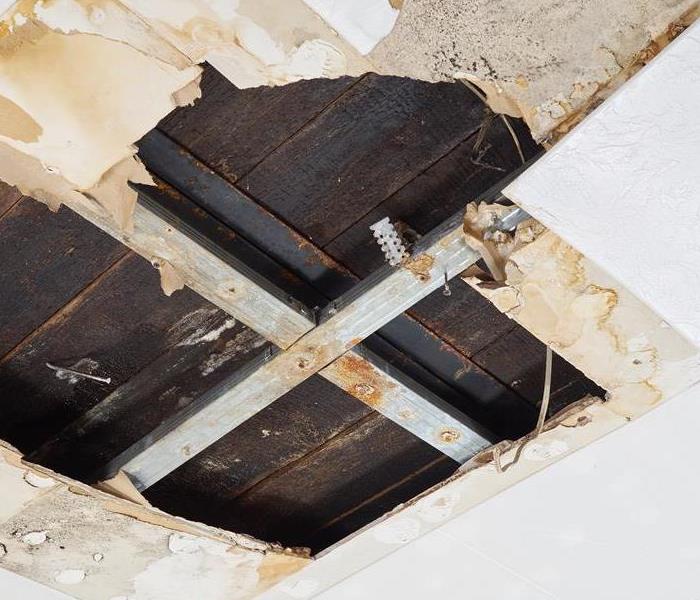 Water damage can happen unexpectedly, give SERVPRO a call at the first sign of damage.
Water damage can happen unexpectedly, give SERVPRO a call at the first sign of damage.
Water damage can happen to anyone at any time, and it's important to be prepared for it. The best way to prevent water damage is by knowing the common causes of it. Below is a list of some of the top reasons you might have experienced water damage in your home or business.
Water Damage From Faulty Pipes
One of the most common causes of water damage is faulty pipes. If you have a leaky pipe or faucet, it can cause serious damage to the walls and floors in your home. The most common types of damage are:
- Leaking pipes
- Clogged pipes
- Burst pipes
When the pipe is worn or damaged, it loses its ability to move water. This means that it can leak or burst, causing a flood and potentially damaging your home.
To avoid this problem, it's important to check the pipes in your home regularly. If they look damaged or have leaks or other signs of wear, call a professional plumber to have them repaired or replaced.
Water Damage in the Gutters
Leaves and debris can clog the gutters, causing them to overflow and cause water damage. If you don't regularly clean your gutters, you may not be aware of any potential problems until it's too late. To prevent your gutters from causing water damage, it is important to clean your gutters at least once per year.
Water Damage From Appliances
Appliances that use water can leak, resulting in damage to your home or business. Leaks are often caused by faulty valves or seals, which may need to be replaced by a qualified technician. The following appliances can cause water damage:
- Water heaters
- Washing machines
- Dishwashers
- Refrigerators
- Furnaces and hot water heaters
Water Damage From Supply Line Leaks
Water damage from supply line leaks is a common problem. Leaks can be caused by loose fittings, corroded pipes, or defective valves. If you suspect a leak in your home's plumbing system, call in a professional to investigate.
Water Damage From Clogged Drains
The most common cause of water damage is clogged drains. This can happen for a number of reasons, including:
- Hair and other debris getting stuck in the drain
- A blockage due to foreign objects or food items being flushed down the toilet
- Grease buildup in pipes
Severe Weather
Severe weather is a common cause of water damage. This can include floods, hurricanes, and tornadoes. When inclement weather occurs in your area, it could cause water damage from leaks or flooding. It can also cause significant structural damage such as roof damage.
During these events, you should take extra precautions to ensure that your property is protected from any storm damage or flooding that might occur.
Water damage can be a serious problem that must be dealt with immediately.
Water damage is a serious problem that must be dealt with immediately. It can cause a lot of damage to your home and lead to mold, mildew, wood rot, and electrical problems.
If you find yourself in this situation, it's important to act quickly. The longer you wait before contacting a professional water damage restoration company, the more likely it is that mold will start growing in your home or business and cause long-term damage.
Reasons for Water Damage from Washing Machines
1/20/2023 (Permalink)
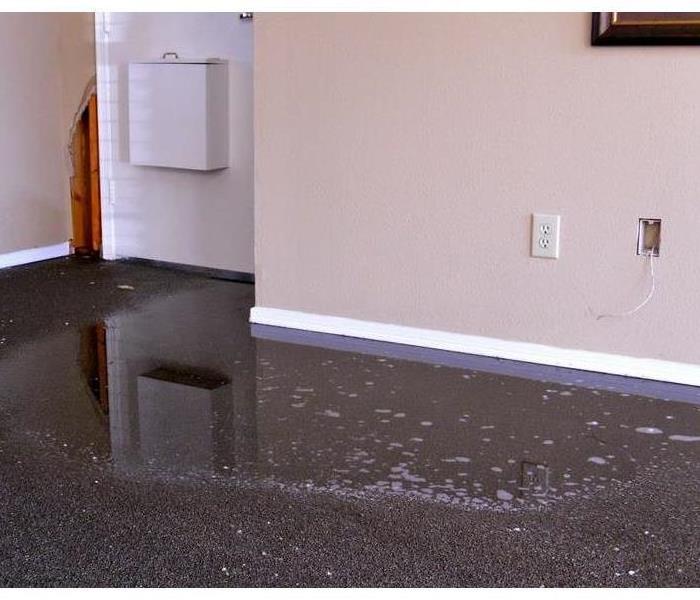 Washing machines are convenient household appliances, but they can also be a source of water damage if they are not properly maintained.
Washing machines are convenient household appliances, but they can also be a source of water damage if they are not properly maintained.
Washing machines are convenient household appliances, but they can also be a source of water damage if they are not properly maintained or if they malfunction. Leaks, overflowing, and other issues can cause water to seep into floors, walls, and other areas of the home, resulting in damage to the structure and belongings. It is important to be aware of the signs of washing machine water damage and to take steps to prevent or mitigate it, such as regularly inspecting and maintaining the machine, being alert for signs of leaks or other issues, and taking prompt action if water damage does occur. Here are some reasons your washing machine might cause water damage in your home.
Faulty Drain Hose
The main cause of washing machine water damage is the drain hose. This part connects to the bottom of your washer, and it's responsible for draining both water and waste from inside the machine. A faulty drain hose can be clogged or disconnected, which will prevent it from draining properly. It can also become damaged by rodents or insects that chew on it, or by other components within your washing machine (such as a broken pump).
Overloaded Washing Machine
Don’t overload your washing machine. If a load of laundry is too big, it can cause the unit to shake, spin out of balance and vibrate heavily during the cycle. This can cause damage to the bearings in your washer's tub and transmission shafts, as well as other vital parts that allow for the smooth operation of your device.
If you're using an electric model with a direct-drive motor (instead of belt drive), don't overload it with more than 8 pounds per cubic foot capacity—this means 3 cubic feet of space should be left empty so there's room for water flow inside your appliance when it spins around at high speeds while doing its job!
The best rule of thumb: always follow manufacturer recommendations on how much clothing capacity should be used before adding new items into each load.
Faulty Seal
There are several ways to check the seal of your washing machine. If you have a front-loading washer, remove the front panel by unscrewing it counterclockwise. If you have a top-loading washer, locate the screws underneath and remove them using an Allen wrench. Next, lift up on the top of your washing machine until you can see where it connects to your wall bracket; this is usually located at either end or in between depending on how tall or wide your model is.
Once you've found where your washer is attached to its base, look for any holes or gaps in its sealant around the outside edges: if there are any cracks or tears visible here then water can seep out of them during use and cause minor damage over time (if not fixed immediately). If these holes exist then call in a professional plumber immediately!
There is one thing that can make all the difference when dealing with a washing machine leak: hiring a professional. The longer you wait before hiring SERVPRO of Boston Downtown/Bay Back/South Boston, the more likely it will be that mold will grow and other areas will be damaged as well. By calling us right away, we are able to respond quickly—before any further problems occur—and begin working on restoring your home back to normalcy once again!
Steps To Take To Avoid Frozen Pipes
11/9/2022 (Permalink)
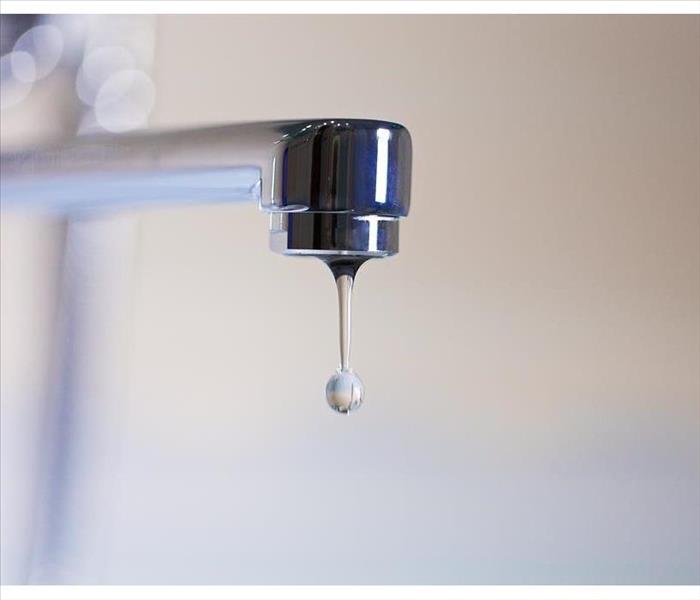 Let the cold-water drip from the faucet served by exposed pipes.
Let the cold-water drip from the faucet served by exposed pipes.
How to Prevent Freezing Pipes
Winter is an exciting time of year, but it is also be a time when you have to worry about frozen pipes. Frozen pipes can cause household plumbing problems that range from inconvenient to costly and even dangerous. As unpleasant as this situation may be, there are some steps you can take to prevent it or at least minimize your risk. Here are some tips for avoiding frozen pipes.
Keep garage doors closed if there are water supply lines in the garage.
If you have an oil or water supply line in the garage, it's best to keep your garage door closed. This will help prevent the pipes from freezing up as much as possible. If you have a water supply line in your garage and you're not sure whether or not it's frozen, contact a professional for advice.
Open cabinet doors
Open kitchen and bathroom cabinet doors to allow warmer air to circulate around the plumbing. The repeated opening and closing of the cabinet’s doors creates a cold-air pocket that can cause pipes to freeze. If you have children, be sure they understand not to close these doors while they're in the room.
Let water drip from the faucet served by exposed pipes.
If you have exposed pipes in your home, let the cold-water drip from the faucet served by exposed pipes. This will prevent freeze damage and help protect your plumbing system from freezing.
Maintain the same setting on the thermostat
Keep the thermostat set to the same temperature both during the day and at night. This will help keep your pipes from freezing as quickly. If you're using heat, make sure it's turned on no lower than 55° F.
If you will be going away during cold weather, leave the heat on in your home.
If you will be going away during cold weather, leave the heat on in your home, set to a temperature no lower than 55° F. It's best not to lower the temperature at night—when it may be warmer inside your home than outside—and when you're asleep and not monitoring it closely. This will prevent pipes from freezing.
It's also important not to turn off the heat when you're away (unless there is an emergency). If nothing else, this can help protect those items that are most likely to freeze: pipes leading into the water heater and any exposed water lines, such as those located near windows or doors that don't get much direct sunlight.
Take steps now to avoid expensive emergency repairs later
In addition to the steps above, you can also take some preventive measures to keep your pipes from freezing. For example, insulate your water heater with a blanket or towel, and check the temperature gauge regularly. If it gets too cold in your home, consider turning on extra heating sources. You may also want to install a space heater near any exposed pipes, so they stay warm enough not to freeze.
If you think that your pipes might have already frozen due to an electrical outage or lack of heat in your home, don't wait until it thaws out—call a plumber immediately! Frozen pipes will often burst when thawed out too quickly; this can lead to a flooding situation that could cause significant damage inside or outside of your house.
We hope that we’ve given you some great tips for escaping the frozen pipe trap and avoiding costly damage to your home. As always, we want to help you stay warm and dry during the winter months. So, if you have any questions or concerns about your own pipes and would like a professional opinion on how best to protect them from freezing—give us a call!
How To Handle an Overflowing Toilet
7/23/2022 (Permalink)
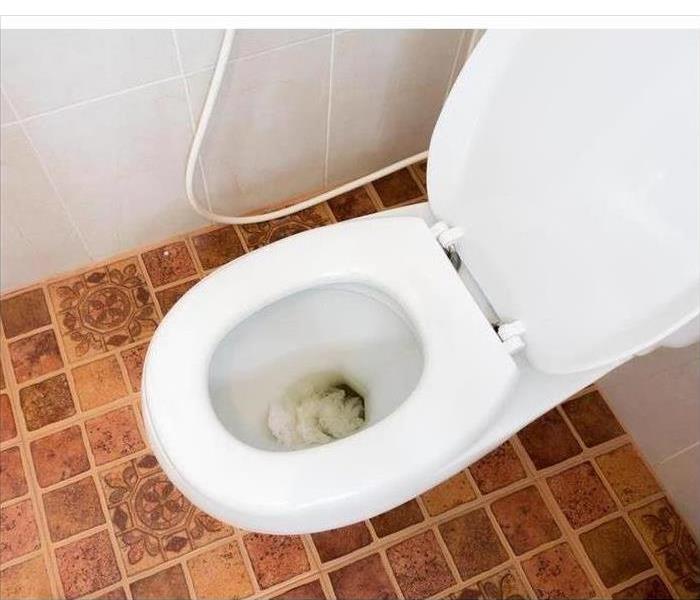 A clogged toilet needs to be dealt with correctly to prevent sewer damage.
A clogged toilet needs to be dealt with correctly to prevent sewer damage.
While toilets may get clogged or not function as they should from time to time, an overflowing toilet can pose a large issue, especially if dealing with a sewage backup. If sewage water enters your home in Boston, MA, it is labeled Category 3 water and needs to be considered an emergency since the bacteria, viruses, and microbes in the contaminated water can cause serious illness and harm to anyone who comes into contact with it. This situation warrants the help of a professional sewage cleanup and restoration company. Here is some useful information for dealing with toilet overflow and sewer damage.
Possible Causes of a Sewage Backup
While you should contact a sewage company whenever a backup occurs, there are several reasons sewage might make its way into your home:
- Clogged or flooded toilet
- Tree roots affecting sewer line
- Damaged, worn, or clogged sewer line
- Municipal sewer backup
How To Deal With a Clogged Toilet
While a clogged toilet is not an emergency in itself, it needs to be dealt with correctly to prevent sewer damage from occurring. Often, a small clog can be handled using a toilet plunger. You should prevent overflowing ahead of time by taking the lid off the tank and pushing the flapper down, which prevents water from entering the bowl. Then turn off the toilet’s main water supply. If a plunger doesn’t fix the clog, you can try using a toilet auger or snake to break up a clog in the drainage pipe. Sometimes, a plunger or auger won’t be enough to fix the issue and will need to be fixed by a professional plumber.
Since sewage backup is grossly contaminated and causes severe harm to any who consumes or comes into contact with it, you should always call a professional sewer damage cleanup company rather than try to clean up the mess yourself. Prevent a toilet overflow from occurring by knowing how to effectively handle clogs.
Secondary Damage Could Be Worse Than the Initial Cause
3/7/2022 (Permalink)
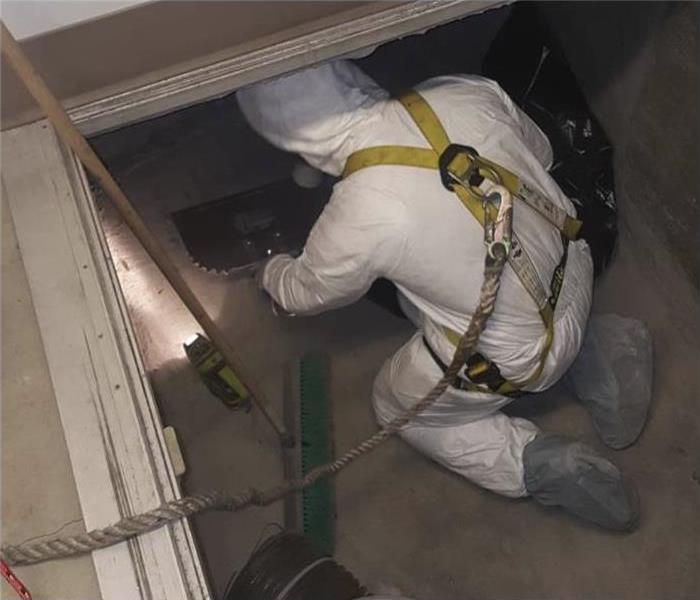 Checking for mold in a crawlspace.
Checking for mold in a crawlspace.
How To Avoid Secondary Damage In Your Building
When one domino fall, it creates a chain reaction, knocking over more. Water intrusion is quite similar to the childhood game. When commercial owners don’t notice it immediately or fail to fix elements of primary breaks, the lingering humidity could lead to secondary complications such as structural deterioration or black mold. The effects of water are severe and costly. Property owners in Chinatown, MA, should understand why it’s concerning and how to avoid it.
1. Lack of Attention Leads to Mold
While fungal spores are always around, these little decomposers become a significant problem for owners when interacting with water. The fluid feeds the microbes, encouraging reproduction. Water exposure, then, is serious business, acting as the trigger. The following conditions demand attention:
- Plumbing leaks or drips
- High humidity levels
- Damp, dark cabinets or closets
- Flooding
- Lingering puddles
Tend to these situations right away to stop secondary trouble from starting.
2. Secondary Issues May Appear First
Sometimes dampness hides, only evident after the moisture penetrates through materials. Early signs of black mold include peeling paint, warped flooring and musty smells. You may also observe unusual stains or spots.
A leak may have started within the crawl space, indiscernible until now. In this case, call in a mold remediation company to investigate. The primary cause should be fixed first. Then, tackle the cleanup.
3. Focus on Drying and Gutting
Fixing secondary damage is a timely process, requiring patience and thoroughness. If not methodically handled, the premises may experience future complications. Extract as much moisture as possible. Use a moisture reader to understand to monitor dampness. Run industrial dehumidifiers around the clock to pull out the humidity from walls, floors, the air and objects.
Also, pull out porous items that have become drenched. These are likely to contaminate the room more, and they cannot be thoroughly cleaned. Perform flood cuts on the drywall, taking out a few feet above the waterline. Toss impacted carpeting and soaked valuables.
Excess water could encourage black mold growth. To safeguard a commercial property from these secondary harms, seek professional help as soon as possible and concentrate on decreasing wetness.
Types of Water Damage Coverage
2/22/2022 (Permalink)
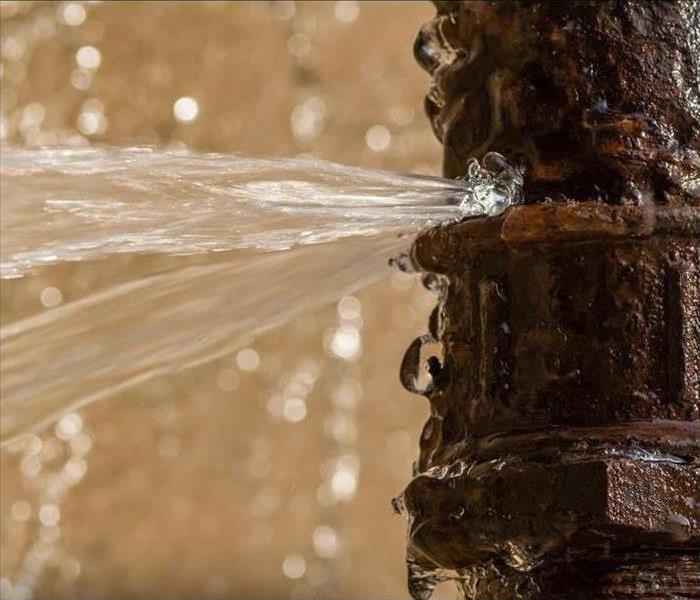 More water damages are caused by broken pipes in North End, MA
More water damages are caused by broken pipes in North End, MA
How to Approach Damaged Pipes and Other Plumbing
Do you know when water damage to your business is covered by your existing insurance policy? Read on to better understand how to approach damaged pipes and other plumbing problems.
1. Floods or Leaks?
While most commercial insurance policies explicitly do not cover the sort of catastrophic flood event that results from extreme rainfall, tidal waves, or overflowing rivers, many other types of water damage are still covered by default plans. For example, leaking pipes and the damage they cause to the surrounding area are usually covered. As long as all issues are correctly documented and ascertained by your adjuster, your insurer will likely pay for a qualified professional water damage restoration service to bring your property back to its original condition.
2. Burden of Maintenance
However, under most default packages, your business damage will not be insured against flooding resulting from negligence. Broadly speaking, these cases usually come down to a lack of preventative maintenance. For example, if a few damaged pipes were noticeably leaking for more than a couple of weeks, it is no longer considered an unpreventable accident. In such cases, the business owner will be liable for all damages, since the flood did not result from a sudden event.
3. Other Exceptions
Coverage for fire suppression systems, such as water-based overhead sprinklers or powder-based devices, is usually more extensive than for the basic plumbing. This is because these systems are necessary for the buildings to be compliant with fire codes and because water does not move through these pipes regularly. While it is important to maintain your fire sprinklers in North End, MA, for safety and legal reasons, it is unlikely that you need an additional insurance coverage package to cover them. Mold damage resulting from moisture retained in the walls or floors is usually not covered, as this is a side effect from a more fundamental plumbing problem.
Don’t allow damaged pipes and other plumbing issues to linger and incur unnecessary costs. Prevent downtime by actively pursuing the appropriate maintenance remedies outlined above.
Cleaning Up After a Leaking Water Heater
2/8/2022 (Permalink)
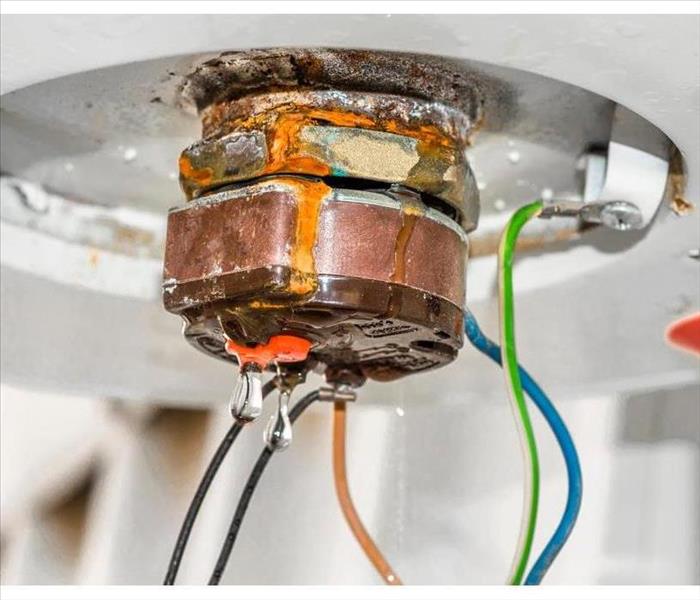 A water heater problem is frustrating.
A water heater problem is frustrating.
Cleaning Up After a Water Heater That Has Leaked
A broken water heater is a nasty surprise that can cause a lot of damage. If you notice your water heater is making funny noises, take some steps to minimize the impact on your home. You don’t want to get caught in the shower with a failed water heater. A leaking water heater can cause a lot of frustration and damage.
Minimizing Damage
If you notice your water heater is acting up, follow these steps to help mitigate any further damage:
- Turn off the power supply.
- Cut off the water.
- Drain your water heater.
- Flip open the pressure-release valve.
- Use cold water to rinse the water heater.
Cleanup Procedures
If you are dealing with a leaking hot water heater, it is important to not just fix the source of the problem but to clean up any water and address any damage that occurred as a result of the leak. Standing water can lead to a lot of frustrating problems. Warm, moist areas are breeding grounds for mold, germs, fungus and all kinds of other pathogens.
Depending on the amount of water you are dealing with, most cleanups require more than just soaking the water up with a towel. Carpet, walls and wood tend to absorb and hold in moisture. It is important to dry out carpets and behind walls where mold can grow undetected.
If you are dealing with a leaking water heater that has caused significant water damage, water mitigation specialists can help you dry things out and prevent secondary damage from occurring. If your home isn’t properly dried out within the first 48 hours, you could be looking at substantial damage.
A water heater problem is frustrating. Don’t let the resulting water damage be an ongoing process. Hire professionals in Financial District, MA, to come in and make sure moisture isn’t trapped behind your walls and that your carpets are thoroughly dried. You don’t want have to deal with mold growth.






 24/7 Emergency Service
24/7 Emergency Service







